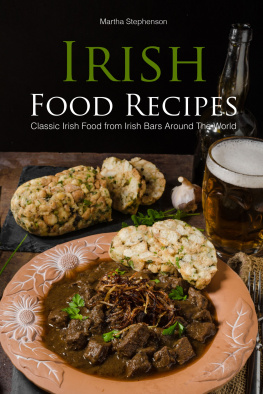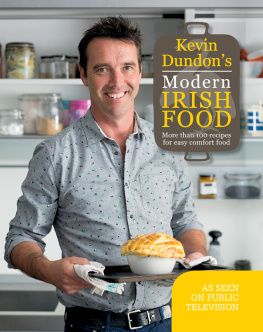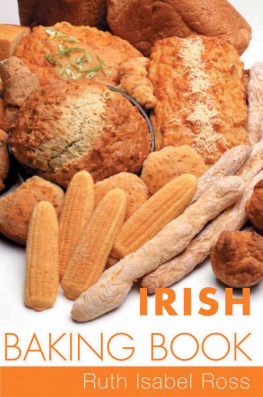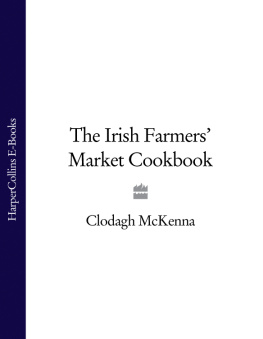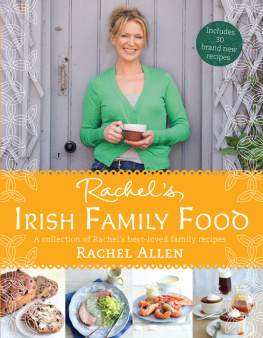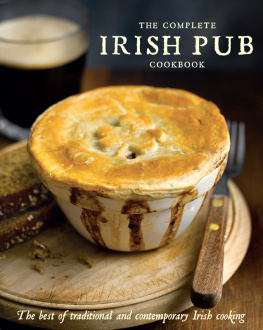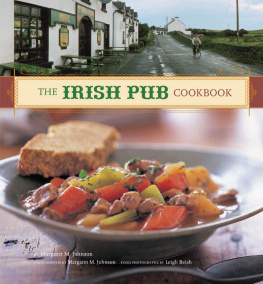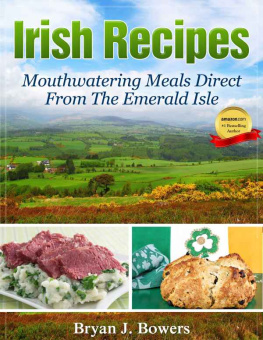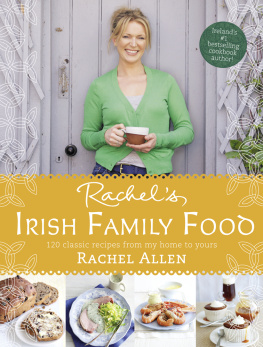REAL IRISH FOOD

REAL
IRISH
FOOD
150
Classic Recipes from the Old Country
DAVID BOWERS

SKYHORSE PUBLISHING
For Hugh and Pearse
Copyright 2012 by David Bowers
All Rights Reserved. No part of this book may be reproduced in any manner without the express written consent of the publisher, except in the case of brief excerpts in critical reviews or articles. All inquiries should be addressed to Skyhorse Publishing, 307 West 36th Street, 11th Floor, New York, NY 10018.
Skyhorse Publishing books may be purchased in bulk at special discounts for sales promotion, corporate gifts, fund-raising, or educational purposes. Special editions can also be created to specifications. For details, contact the Special Sales Department, Skyhorse Publishing, 307 West 36th Street, 11th Floor, New York, NY 10018 or info@skyhorsepublishing.com.
Skyhorse and Skyhorse Publishing are registered trademarks of Skyhorse Publishing, Inc., a Delaware corporation.
Visit our website at www.skyhorsepublishing.com.
10 9 8 7 6 5 4 3 2 1
Library of Congress Cataloging-in-Publication Data is available on file.
ISBN: 978-1-61608-870-5
Printed in China
METRIC AND IMPERIAL CONVERSIONS

OVEN TEMPERATURES
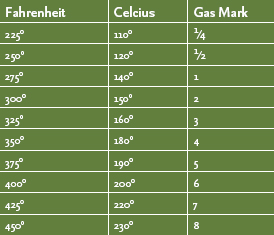

CONTENTS
INTRODUCTION

Ireland is a stunningly beautiful country. First-time visitors are always surprised to see the grass really is emerald green, and that it stays that way through the year. In the spring, bluebells sprout so profusely the gardens are a dense blue haze. Summer is a riot of foliage and morning birdsong. Autumn is full of soft mists and glowing light, and winter brings on picturesque hoarfrost that covers the hedges like icing. Everywhere you look, theres an MGM movie set of land and water and sky.
But when I think of Ireland, I think of food.
Brown soda bread so moist it barely needs the yolk-yellow butter; sweet, briny oysters so fresh they quiver on the shells; fragrant apple tarts under tender, golden crusts; rich, heartwarming stews redolent of meaty gravy and nut-sweet carrots; crisp-edged potato cakes flipped hot from a cast-iron skillet directly onto your plate.
Forget meatloaf and macaroni and cheesethis stuff is the original comfort food.
Real Irish food is more in the style of traditional French country foodnot the formalized cooking of chefs, but the classic dishes with regional variations passed down from generations of home cooks. Each bonne femmes variation on boeuf en daube finds its counterpart in Irish stew, the countless versions of tartes au citron and mousses au chocolat are echoed by very distinct apple tarts and fruitcakes, and that extra fillip that gives life to a regional saucisson can be seen in each artisanal black pudding. Real Irish food is full of flavor and subtlety, based on prime ingredients treated with care and respect. Real Irish food is astonishing in its depth and range and mastery.
In the same way Italian food is about more than spaghetti and meatballs, real Irish food is a far more complex and exciting thing than the corned-beef-and-cabbage caricature we tend to think of in North America.
I know because I grew up eating the glories of Irish food, and Ive missed it nearly every day of the last 20 years I have lived in the United States.
Based on my experience of St. Patricks Day dinners in the US, I can forgive any American for expecting real Irish cooking to be boring and bland. All that watery cabbage? Ugh, no thanks.
Happily, those once-a-year cooks are wrong about nearly everything (and one of them, whom I had to re-educate, was my own American wife!). Over the last 20 years, we have continued to divide our time between Ireland and the US, spending a good deal of time in Ireland, both living there and traveling around, and always eating, eating, eating. Indeed, one of the great pleasures of our culinary life was watching the face of our oldest son when, as a toddler, he gnawed on his first Irish sausage with a look of wonder while he joyfully repeated the Irish Gaelic word for sausage Id just taught him: Ispini! Ispini! Ispini!
My parents have been the source of endless education about real Irish food from both coasts. My mother is from County Mayo, on the west coast of Ireland, one of the few places where the Irish language is still spoken and almost a land unto itself in its regional isolation. My father, in his day, was a home cook so proficient I can only describe him as smokin. He was born and bred in Dublin, the heart of the country (from anywhere else in Ireland, one goes up to Dublinto all other places, one goes down the country). Together, my parents raised a family of four sons who are serious eaters and cookshalf of us professionals.
Between my mom and dad alone, I sampled an enormous range of dishes and regional styles at a young age. From them, I also learned surprising culinary trivia, such as the fact that black pepper was unknown in the Ireland of their youth. White pepper was the usual seasoning, and black pepper didnt appear regularly in stores and markets until the 1960's, when it was considered a daring and Italianate seasoning.
From them and my grandparents, I learned about the bastible, the cast-iron pot that served as a stove in traditional Irish cottages, and the moist and flavorful soda bread that emerges from it after half an hour over a turf fire. Growing up in Ireland, I learned to appreciate the beauty of Irish fruits and berries, which grow beautifully in a cold, damp climatefrom wild strawberries and blueberries dotting the hillsides to the first crop of enormous golden raspberries, bursting with flavor, and cooking apples that practically beg to be made into cakes and tarts. And I have a terrific North Dublin recipe for Irish stew that includes fluffy, raisin-flecked dumplings. I learned about seafood, that at home we call leppin fresh, from the pale pink tones of true wild salmon (the dark red color of farmed salmon comes from their feed) to enormous scallops with the roe still attached. Even today, every trip back home to an Irish kitchen leaves me amazed at the incredible variety of foods, the caliber of ingredients, and the ingenuity of Irish cooks.
Most Irish people are horrified by what Americans think of as Irish food. Thats because the real thing is much subtler, more infinite in variety, and more tantalizing and seductive than any parsley-sprinkled platter of overcooked meat and mushy vegetables could ever hope to be. A prominent Irish chef told me recently, When I was studying at Johnson and Wales in America, my roommates family invited me for dinner, and they said, Were making your favorite meal! It was corned beef and cabbage, and I had literally never heard of it before.
Real Irish food is influenced by traditions dating back to the Middle Ages, when monks made the rigors of silence and celibacy more palatable with moist, honey-sweetened oatcakes and fortified themselves against pillaging invaders by brewing up heartwarming soups, dense with barley and vegetables. And centuries before that, the Brehon laws enshrined the cow as the most valuable piece of property a Hibernian could own, marking butter and milk and certainly beef as foodstuffs to be treasured and celebrated. (Its a sentiment anyone would endorse today when tasting Irelands bright-yellow, low-moisture butter, the result of grass-fed cows. Whats more, in Ireland this isnt a premium productits just butter.)
Next page



